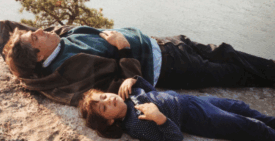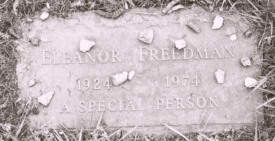
It happens every year. I’m striding past the perfume counter in a department store, or the dairy aisle of the supermarket when I stop suddenly in my tracks, feeling completely disoriented. Something’s out of place and it takes a minute before I can put my finger on it. The clues help. A tower of red and green boxes stacked in the shape of a tree. The premade tube of sugar cookies’ whose wrapper is suddenly green. When telltale notes of the dubious holiday classic, “Baby It’s Cold Outside,” finally waft down from above.
And then, I realize…though hardly cold outside, the holidays have arrived.
As a trauma therapist specializing in grief and loss who also buried her parents within two years of each other, I am acutely aware of both how early the holidays begin each year and the relentless cultural expectation that they be happy, full of over-eating, overspending, and family.
But for many of us, the holidays are a concrete reminder of forever empty chairs at our table that can never be filled.
Alone and lonely are not on brand for how our culture makes us believe we are supposed to feel during the four weeks between Thanksgiving and New Year’s. Unsure of how to navigate the emotional discord of how things really feel, many people who are navigating loss at the holidays simply end up opting out of group celebrations––which of course, leaves them feeling alone and lonely.
“I don’t want to depress people,” my client Holly told me. Thirty-seven years old and a widow, Holly had revealed to me an increasing sense of isolation and sadness as the second Christmas without her husband Doug approached. Doug was only forty when he died of an aggressive melanoma, leaving her to raise their two daughters, who were just two and four. Doug’s death anniversary had coincided with her family’s reunion that summer, so Holly opted out. She felt sure no one wanted a “sad widow” around while they were enjoying an afternoon of jet-skiing. Holly cried every night of the weeklong vacation she didn’t join, missing her old life, her husband, and the fun her kids weren’t getting to have with their cousins.
With the holidays fast approaching, Holly described to me in session feeling much the same as she had in the summer – “mostly sad, mostly a bummer” – but she was determined to find a way to face her inevitable hard feelings about Christmas without also isolating. We used our time in therapy to create a three-part grief plan. The hope was less to prevent feelings of grief and loss at the holidays, which are inevitable, and more to allow Holly a way to feel a part of her family rather than an unwanted burden.
Holly decided to establish a morning grief practice which would allow her to feel her grief first thing. She got up ten minutes earlier and did a meditation that included a body scan and asking herself the question, “where is my grief?” Once she found a “hot spot,” she imagined it as a wound that needed care and attention and asked it to help her. Holly sealed her practice with four counts of box breathing and, for the rest of the day, adopted a “Sherlock Holmes” attitude, looking for clues as to what might tend to the grief wound she’d identified that morning. By approaching the problem with curiosity and compassion rather than judgment, Holly created a hypothesis of what might be needed. Sometimes it was rest or a walk with a friend, but other times she was surprised to discover it was a conversation with a friend she felt let her down, or singing with the girls at the top of their lungs to Taylor Swift in the car. Holly’s oldest daughter noticed her mother’s new energy and asked about it. When Holly explained she had created a daily routine for her grief, Holly’s daughter shared that she had a grief practice as well.
“Every day I ask myself, what part of this day would have been Daddy’s favorite?” Turns out that helped her feel close to her father who had always had a “bright side” attitude.
Holly’s daughter’s “bright side” exercise beautifully exemplifies one of the modern grief theories that gives a better description of grief than Elisabeth Kubler Ross’ now defunct five stages. The “continuing bonds” model (Sliverman, Klass, Nickman) simply encourages grievers to find ways to stay connected to their deceased loved one rather than stop loving them –– like asking yourself what part of the day your loved one would have cared the most about. Partnered with the Dual Process model (Stroebe & Schut), that highlights an emotional pendulum that swings between thoughts and behaviors that are focused on the past, and are loss oriented, versus behaviors that are focused on living in the present. A thoughtful and adaptive grief practice can help negotiate the space between the pendulum swings.
Wanting to add a grief practice that was specifically holiday related, Holly and her children considered doing a Thanksgiving turkey trot to honor Doug’s love of fitness. Their great idea fell apart when Holly developed shin splints during her second training run. Doug had been a wonderful cook who often included the girls in dinner prep. So, they decided to try perfecting one of Doug’s favorite holiday desserts –– cream cheese press cookies instead. The result was dozens of delicious batches shared with teachers, friends and even the mailman. He said they reminded him of his mother who’d been dead over twenty years, which made them all cry “in a good way,” Holly said.
Holly decided that she did want to attend Christmas at her mother’s, but she had a request: to set a place for Doug at Christmas dinner. When her mother reacted with concern – “won’t that make you sad?” – Holly was ready with a caring and honest answer: “We already are sad, but the chair will help me and the girls feel like there is room for our sadness, and help remind everyone that we miss Doug’s presence, especially during the holidays.”
Do you have an empty chair this holiday season? Here are three steps that helped Holly and her family and which may help you:
Make A Feelings List
Holly made a comprehensive list of all the difficult feelings she anticipated she might face over the holidays. These included anger, jealousy, fear, resentment, confusion, guilt, and pessimism, but also joy.Though intellectually she knew Doug would want her to be happy, she had found joy to be one of the hardest emotions to experience. “Why should I get to be happy, when he died so young and in so much pain?” With her comprehensive list written out, Holly noticed she felt more calm.
Create a Way to Celebrate with Others
Doug loved trucker’s hats. A point of playful contention in their relationship, Doug had insisted on buying a hat at every hipster coffee shop and ski resort he visited, and friends made a habit of giving them as gifts. With the help of her girls, Holly picked out thirty of his more than 500 hats and brought them to Christmas Eve dinner, where they set one at each dinner place.Her family’s reaction included laughter, tears, and lots of stories about Doug and his hats.
Invite People In
A week before Christmas, Holly sent an e-mail to her entire extended family, acknowledging her fear of “bumming people out.” She also acknowledged that she didn’t want to only feel sad because Doug was not there to celebrate with them. Every person responded, including her teenage nephew, who shared a touching story she hadn’t heard before, about how Doug had helped him struggle through his college decision.
Meghan Riodan Jarvis is a clinical psychotherapist and the author of End of the Hour: A Therapist’s Memoir.








